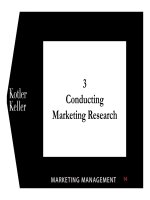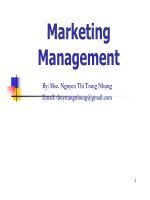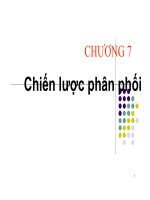Lecture Marketing management: Chapter 3 – Nguyễn Thị Trang Nhung
Bạn đang xem bản rút gọn của tài liệu. Xem và tải ngay bản đầy đủ của tài liệu tại đây (1.88 MB, 52 trang )
1
3
Conducting
Marketing Research
Chapter Questions
What constitutes good marketing research?
What are the best metrics for measuring
marketing productivity?
How can marketers assess their return on
investment of marketing expenditures?
Copyright © 2011 Pearson Education, Inc. Publishing as Prentice Hall
4-2
Introduction
The marketing environment is changing:
From local to national to global marketing
From buyer needs to buyer wants
From price to nonprice competition
The need for real-time market information is
greater than at any time in the past
Copyright © 2011 Pearson Education, Inc. Publishing as Prentice Hall
1-3
Venus Razor
Copyright © 2011 Pearson Education, Inc. Publishing as Prentice Hall
4-4
What is Marketing Research?
Marketing research is the systematic design,
collection, analysis, and reporting of data
and findings relevant to a specific
marketing situation facing the company.
Copyright © 2011 Pearson Education, Inc. Publishing as Prentice Hall
4-5
Types of Marketing Research Firms
Syndicated
Firms gather consumer and
trade information, which they
sell for a fee
Nielsen Media research
These firms are hired to carry
out specific project
Custom
They design research and
report finding
Providing specialized research
services
Specialty-line
They sell field interviewing
services to other firms
Copyright © 2011 Pearson Education, Inc. Publishing as Prentice Hall
4-6
The Marketing Research Process
Define the research problem and
objectives
Develop research plan
Collect information
Analyze information
Present findings
Copyright © 2011 Pearson Education, Inc. Publishing as Prentice Hall
4-7
Step 1: Define the Problem
Define the problem: What is research problem and Why
they conduct the research? Defining research problem
should not be broadly or narrowly
A case study:
American Airlines is constantly looking for new ways to serve its
passengers. One manager came up with the idea of offering phone
service. The other manager got excited about this idea. The marketing
manager volunteered to do some preliminary research. He conducted a
major telecommunications company to find out the cost of providing this
services on B 747 coast to coast flights. The telecommunications
company said that the equipment would cost the airline about $1000 a
flight. The airline could break even if it charged $25 a phone call and at
least 40 passengers made calls during the flight. The marketing
manager then asked the company’s marketing research manager to
find out how air travelers would respond to this new service.
Copyright © 2011 Pearson Education, Inc. Publishing as Prentice Hall
4-8
Step 1: Define the Problem
“Find out everything about air traveler’s needs”.
“Find out if enough passengers aboard a B747 flying
between the East Coast and West Coast would be
willing to pay 25 USD to make a phone call so that AA
would break even on the cost of offering this service
“Will offering an in-flight phone service create
incremental preference and profit for AA to justify its
cost again other possible investments American might
make?”
Copyright © 2011 Pearson Education, Inc. Publishing as Prentice Hall
4-9
Step 1: Define the Problem
Research objective statement:
1.
2.
3.
4.
5.
6.
What are the main reasons that airline passengers place phone
calls while flying?
What kinds of passengers would be the most likely to make calls?
How many passengers are likely to make calls given different piece
levels?
How many extra passengers might choose American because of
new service?
How much long-term good will this service add to AA image?
How important is phone service relative to improving other factor
such as flight schedules, food quality and baggage handdling?
Copyright © 2011 Pearson Education, Inc. Publishing as Prentice Hall
4-10
Types of Research
Exploratory
-To shed light on real natural of the problem
- Suggesting possible solutions or new idea
Descriptive
-Using descriptive data analysis
Causal
-Causal and effect relationship
Copyright © 2011 Pearson Education, Inc. Publishing as Prentice Hall
4-11
Step 2: Develop the Research Plan
Data sources
Research approach
Research instruments
Sampling plan
Contact methods
Copyright © 2011 Pearson Education, Inc. Publishing as Prentice Hall
4-12
Data sources
Copyright © 2011 Pearson Education, Inc. Publishing as Prentice Hall
4-13
Research Approaches
Observational and ethnographic
Focus group
Survey
Behavioral
Experimental
Copyright © 2011 Pearson Education, Inc. Publishing as Prentice Hall
4-14
Research approach
Observational research
Observing the relevant actors and settings
For example: Observing the different carriers
of AA at airport, airline office,...in competitor’s
Focus group
Inviting 6-10 people working in few hours
with a skilled moderator
Discuss about products, service,
organization and other marketing entity
This group is facilitated by a skilled
moderator
Copyright © 2011 Pearson Education, Inc. Publishing as Prentice Hall
1-15
Research approach
Focus group – remember
The skilled moderator must be:
Objective
Knowledgeable
skilled in group dynamic
The discussion must be:
Recorded by possible equipment
Oriented on consumer belief, attitude,
behavior
Copyright © 2011 Pearson Education, Inc. Publishing as Prentice Hall
1-16
Focus Groups
Copyright © 2011 Pearson Education, Inc. Publishing as Prentice Hall
4-17
Research approach
Survey research
It’s the best suited for descriptive research
Behavioral data:
Customer’s behavior traces recorded by
store scanning data, catalog purchase
record and customer databases
Focus on the brand they use, price they
don’t buy….
Copyright © 2011 Pearson Education, Inc. Publishing as Prentice Hall
1-18
Research Instruments
Questionnaires
Qualitative Measures
Technological Devices
Copyright © 2011 Pearson Education, Inc. Publishing as Prentice Hall
4-19
Qualitative Techniques
Word Associations
Visualization
Projective Techniques
Laddering
Copyright © 2011 Pearson Education, Inc. Publishing as Prentice Hall
4-20
Questionnaire Do’s and Don’ts
Ensure questions are
free of bias
Make questions simple
Make questions specific
Avoid jargon
Avoid sophisticated
words
Avoid ambiguous words
Avoid negatives
Avoid hypotheticals
Avoid words that could
be misheard
Use response bands
Use mutually exclusive
categories
Allow for “other” in fixed
response questions
Copyright © 2011 Pearson Education, Inc. Publishing as Prentice Hall
4-21
Question Types - Dichotomous
In arranging this trip, did you contact
American Airlines?
Yes No
Copyright © 2011 Pearson Education, Inc. Publishing as Prentice Hall
4-22
Question Types – Multiple Choice
With whom are you traveling on this trip?
No one
Spouse
Spouse and children
Children only
Business associates/friends/relatives
An organized tour group
Copyright © 2011 Pearson Education, Inc. Publishing as Prentice Hall
4-23
Question Types – Likert Scale
Indicate your level of agreement with the
following statement: Small airlines generally
give better service than large ones.
Strongly disagree
Disagree
Neither agree nor disagree
Agree
Strongly agree
Copyright © 2011 Pearson Education, Inc. Publishing as Prentice Hall
4-24
Question Types –
Semantic Differential
American Airlines
Large ………………………………...…….Small
Experienced………………….….Inexperienced
Modern……………………….…..Old-fashioned
Copyright © 2011 Pearson Education, Inc. Publishing as Prentice Hall
4-25









